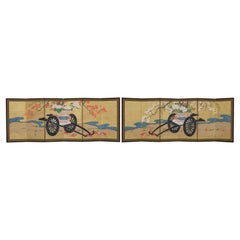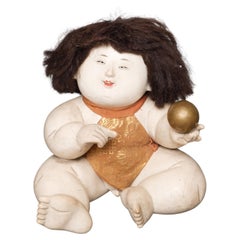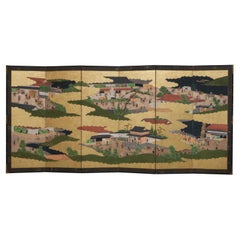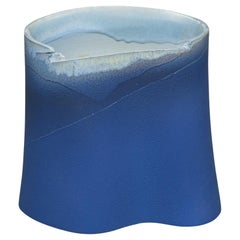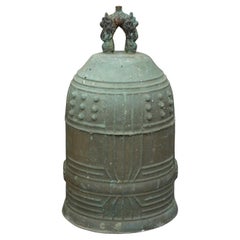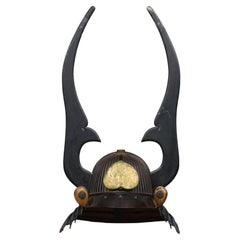Japanese Antique Store
to
17
11
9
6
5
4
4
3
1
1
1
1
1
1
1
1
1
1
Located in Amsterdam, NL
An amazing pair of six-panel hinagata byôbu (doll festival folding screens) with a continuous painting on gold leaf showcasing flower carts (hana’guruma) at the edge of a winding river.
Both laden with a large bamboo basket...
Category
Antique Early 19th Century Japanese Paintings and Screens
Materials
Gold Leaf
Located in Amsterdam, NL
A charming gosho’ningyô (palace doll) of plump, seated child with a brilliant white skin and a small delicately ...
Category
Antique Early 19th Century Japanese Antiquities
Materials
Paste, Silk, Paint
Located in Amsterdam, NL
An elaborate, large six-panel byôbu (folding screen) featuring a detailed genre painting on gold leaf, capturing...
Category
Antique Early 19th Century Japanese Paintings and Screens
Materials
Metal, Gold Leaf
By Andô Hironobu
Located in Amsterdam, NL
Magnificent and large Japanese organically-shaped oval stoneware vase decorated ...
Category
Late 20th Century Japanese Ceramics
Materials
Stoneware
Located in Amsterdam, NL
A heavy traditional bronze temple bell (bonshô), boasting a bright green patina and a resonant sound.
The top h...
Category
Early 20th Century Japanese Metalwork
Materials
Bronze
Located in Amsterdam, NL
An old and exceptional completely lacquered akoda-nari suji’bachi kabuto (helmet with raised ridges) with a bron...
Category
Antique 18th Century Japanese Antiquities
Materials
Bronze, Copper, Iron
Located in Amsterdam, NL
Very large ovoid shaped porcelain vase with a beautiful blue and white mountainscape design accentuated by a low...
Category
20th Century Japanese Ceramics
Materials
Porcelain
Located in Amsterdam, NL
Superb rectangular black lacquer tebako (box for personal accessories) with a slightly domed well-fitted lid.
T...
Category
Early 20th Century Japanese Lacquer
Materials
Lacquer
Located in Amsterdam, NL
Elegant lacquered tiered jûbako (picnic box) comprising five stackable tiers, two covers, and a raised tray. Eac...
Category
Early 20th Century Japanese Lacquer
Materials
Giltwood, Lacquer
By Mitsuo Takana
Located in Amsterdam, NL
Refined, tall two-panel byôbu (folding screen) completely adorned with ‘Wajima Ryûsaku’ lacquer by the Nitten award winning artist Mitsuo Takana (1956).
Featuring five refined images inspired by woodblock prints from the famous series ‘Tôkaidô gojûsan tsugi’ (The fifty-three stations of the Tokaido road), like the 1st station Nihonbashi, the 10th station Hakone, and the 21st station Okabe.
The design is executed in hiramaki-e (low-relief lacquer design) in shades of gold, silver, heightened by some multi-coloured details. Set on a shiny black lacquer substrate.
Signed in red lacquer in the lower right corner.
Including original signed & sealed wooden tomobako (storage box). The front with an inscription about the contents as described above. The inside:
‘Friend of the Nitten Exhibition Takana Mitsuo’ - Seal: ‘Hikari’.
‘Lacquer artist Wajima Ryûsaku’ - Seal: ‘Ryûsaku’.
Mitsuo Takana was born 1956 in Wajima, Ishikawa prefecture. He won several awards during exhibitions like: Ishikawa Contemporary Art Exhibition, Japan Artisans' Association Exhibition and the well-known Nitten Exhibition.
Dimensions:
Height 57.48 in/146 cm, Total width 66.92 in/170 cm (2 x 33.46 in/85 cm), Depth 1.10 in/2.8 cm.
Weight 56.21 lb/25.5 kg.
Wajima lacquerware...
Category
Late 20th Century Japanese Paintings and Screens
Materials
Wood, Giltwood, Lacquer
Located in Amsterdam, NL
A very colourful and captivating large six-panel byôbu (folding screen) with a refined continuous painting of a luscious flower garden filled with many different types of chrysanthemums (kiku), next to a winding river.
This multi-coloured painting is set on a shiny gold-leaf background, and the chrysanthemum flowers are painted by using shell paste (gofun) in low relief.
Several clutches with a great variety of chrysanthemum flowers are in full bloom and they each show their unique form and colour. Varying from white, red, yellow and pink. The flowers bloom all around and on different kinds of bamboo fences and trellises.
In Japan chrysanthemums are believed to represent happiness, love, longevity and joy.
The panels are surrounded by two silk borders, a thin black one, and a wide brown one. The screen is protected by a black and red negoro’nuri...
Category
Antique Late 19th Century Japanese Paintings and Screens
Materials
Gold Leaf
Located in Amsterdam, NL
A remarkable round chadansu (tea cabinet) crafted from a hollowed tree trunk, resting on an organically shaped t...
Category
Early 20th Century Japanese Furniture
Materials
Wood
Located in Amsterdam, NL
An antique, outstanding signed suji’bachi kabuto (helmet with ridges) surmounted by a gilt metal maedate (forecr...
Category
Antique Late 18th Century Japanese Antiquities
Materials
Metal, Iron
Located in Amsterdam, NL
Pair of impressive, antique kakejiku (hanging scrolls) showcasing the awe-inspiring Niô guardians...
Category
Antique Early 18th Century Japanese Paintings and Screens
Materials
Brocade, Silk, Paint
By Hattori Toshio (Shunsho)
Located in Amsterdam, NL
A small Japanese black and gold lacquer suzuribako (writing box) with cartwheels in water, by the artist Hattori Toshio (1943).
Of rectangular form with rounded corners, bearing a lustrous rôiro ground throughout, the exterior sides of the box and exterior of the cover finely decorated in gold and little silver takamaki-e with cartwheels flowing in a dynamically executed body of water with many swirls
and gushes as well as scattered dew drops, the interior tray fitted with a rectangular ink stone and silver suiteki (waterdropper).
The underside signed ‘Toshi’.
With the original wooden tomobako with hakogaki reading Namikuruma makie suzuribako (The
writing box set, with a design of wheels in water), as well as a leaflet written in Japanese with the artist’s biography up to 1987.
Hattori Toshio (b. 1943), art name Hattori Shunsho, was first selected for the Nitten exhibition in Showa 38 (1963). Since then, he has exhibited more than twenty times at the Nitten and other exhibitions, winning numerous prestigious awards. In 1995,
he had an audience with Pope John Paul II and presented the Pope with a lacquer reading table. In 2004, he created the shelves for the guest room of the Kyoto State Guest House of the Government of Japan. He is a member of the Kyoto Crafts Artists Association, the Kyoto Lacquer...
Category
Late 20th Century Japanese Lacquer
Materials
Wood, Giltwood, Lacquer
Located in Amsterdam, NL
Remarkable and very large bronze 4-tiered trumpet vase intricately designed with a motif of tumultuous waves.
It...
Category
Antique Late 19th Century Japanese Metalwork
Materials
Bronze
Located in Amsterdam, NL
Pair of enticing cast iron chôshi (sake kettles) with a detailed lacquered lid, raised by three low feet. Its ro...
Category
Antique Early 19th Century Japanese Antiquities
Materials
Silver, Iron
Located in Amsterdam, NL
Important unique set of two suits-of-armour (yoroi), complete with two high six-panel screens, that belong together as is indicated by the used family crests (mon). Two crests are used, both belonging to the Nakagawa family of Oka Castle, Ôita prefecture on Kyûshû.
They are:
– the Nakagawa-kurusu, a circle depicting a Celtic-like cross through a ring.
The cross was originally a Christian symbol but after the ban on Christianity in Japan the use of a hidden cross in family crests could continue.
– the Nakagawa-kashiwa, two leaves of the Japanese Emperor Oak turned to each other (dakikashiwa mon).
The remarkable aspect of this ensemble is the presence of matching crests on both the yoroi and the accompanying folding screens. The kurusu and kashiwa crests adorning the yoroi are elegantly replicated on the screens, providing compelling evidence that these pieces form a harmonious and unified set. This exceptional cohesion between the armour and screens further enhances their artistic and historical value.
After the warlord Toyotomi Hideyoshi (1537-1598) had interfered in the battle between the Lord of Bungo Province Ôtomo Yoshi-mune (1558-1605) and the Shimazu of Hyûga Province, he split the Bungo Province in a number of small fiefs and transferred in 1594 Nakagawa Hideshige (1570-1612) from Miki Castle
in the Harima Fief to Oka Castle in Kyûshû.
The Nakagawa family stayed in possession of Oka Castle till the abolishment of the military use of castles in 1873. In 1884 the Nakagawa family received the title of Count (a title in use till the abolishment of aristocracy in 1947).
After the Nakagawa’s left, the castle and the building soon dilapidated and is now known as Oka Castle Ruins. The castle is located in Taketa Village part of Taketa Town in Ôita Province on Kyûshû.
> Set of two tall byôbu (folding screens),
painted with large red jinmaku (camp enclosure curtain) on a gold leaf ground. The curtains show both crests of the Nakagawa family: one screen depicts two Nakagawa-kurusu crests next to a Nakagawa-kashi crest in the middle, and the other shows the symbols the other way round.
Dimensions:
Total width 148.66 in/377.6 cm (2 x 25.35 in/64.4 cm, 4 x 24.48 in/62.2 cm); Height 72.63 in/184.5 cm.
Period: Japan – Late Edo period (First half 19th century), and maybe even older.
> Yoroi with Nakagawa-kashiwa crest:
A Japanese black lacquered suit-of-armour (yoroi) completely laced with orange cords (kuro’urushinuri hi’ito odoshi nimai’dô’maru).
A thirty-two plate suji’bachi kabuto (helmet with raised ridges) with in front a maedate (fore crest) -with traces of gilding- in the shape of flames, resembling a mythical flaming bird flying down. The fukikaeshi (face guards) and the mabizashi (visor) have the Nakagawa-kashiwa crest in gold maki-e lacquer.
Five curved ‘itazane’-plate neck guards (shikoro) laced with orange cords.
Together with an ‘angry man...
Category
Antique 18th Century Japanese Antiquities
Materials
Metal, Iron, Gold Leaf
By Kanaya Gorôsaburô XI 金谷五良三郎
Located in Amsterdam, NL
Elegant brown patinated bronze trumpet vase with gold and red sprinkled design. It has an impressive broad outwa...
Category
Early 20th Century Japanese Metalwork
Materials
Bronze
Located in Amsterdam, NL
Alluring, well-made Kamakura-bori (lit. Kamakura carved) solid wooden étagère table with elaborate carvings depi...
Category
Early 20th Century Japanese Furniture
Materials
Wood
Located in Amsterdam, NL
A massive and exceptional bamboo hanakago (ikebana flower basket). The unusual and modernist basket with a loop ...
Category
20th Century Japanese Decorative Baskets
Materials
Bamboo
By Kosuge Kogetsu
Located in Amsterdam, NL
Tall woven bamboo and rattan baluster-shaped ikebana flower basket (hanakago) with a loop handle by Kosuge Kôget...
Category
Early 20th Century Japanese Antiquities
Materials
Bamboo
Located in Amsterdam, NL
A lovely pair of very detailed carved wooden temple ornaments (kibana) in the sha...
Category
Antique Early 19th Century Japanese Sculptures and Carvings
Materials
Wood
Located in Amsterdam, NL
Large and heavy Japanese light brown patinated bronze footed water basin (suiban) with a mottled golden motif. The bowl with stepped concave rings...
Category
Early 20th Century Japanese Metalwork
Materials
Bronze
Located in Amsterdam, NL
Uncommon ecru lacquer tea caddy (natsume) with a nice golden hiramaki-e (low-relief design) of cart...
Category
20th Century Japanese Lacquer
Materials
Giltwood, Lacquer
Located in Amsterdam, NL
A lacquered 4-piece inrô with a covering design of fireflies (hotaru) flying over helms of grass and around a lantern (andon), shining attractively for the fireflies. Surrounded by rims embellished with a scrolling vine design (karakusa).
Executed in golden hiramaki-e (low-relief lacquer design) and takamaki-e (high-relief lacquer design) with small red accents on the wings and kirigane, (cut and inlaid pieces of gold leaf) at the tails of the fireflies to accentuate the ‘light’ they exude. Set on a glossy black lacquer background.
The compartmentalized interior coated with nashiji (sprinkled gold lacquer)finished with fundame rims (matt gold lacquer).
Laced with purple silk cords, with a brown glass bead ojime, and 2-part manjû netsuke...
Category
Antique Late 19th Century Japanese Lacquer
Materials
Silk, Glass, Lacquer
Located in Amsterdam, NL
Exceptional, rare and completely restored wooden Sado ishô dansu (cabinet of drawers) with elaborately decorated open work iron hardware, in two sections. Fully restored, cleaned and waxed.
The exterior is made of hinoki cypress wood. Only slightly varnished, giving it a tad warmer colour. This soft underground lets the refined hardware stand out even more.
The upper part consists of two large drawers. The lower part with two drawers of different size and a hinged door. The interior behind the door with three small drawers. All the drawers are very deep and have a lot of volume, for easy storage. They run very smoothly as well.
The cabinet has extensively decorated hardware. The corner pieces of the drawers with stylized pine trees. The large decorative lock plates each with their own unique design of different auspicious animals; a peacock, a phoenix, a crane and a minogame. The hinged door decorated with different attributes of the Seven Gods of Fortune...
Category
Antique Late 19th Century Japanese Furniture
Materials
Iron
By Katsukawa Shunsen
Located in Amsterdam, NL
Original Japanese woodblock print by Katsukawa Shunsen (Shunko II) (1762- circa 1830): five karako (Chinese boys...
Category
Antique 1810s Japanese Prints
Materials
Paper
Located in Amsterdam, NL
Very refined Japanese bronze okimono of a ‘karasu tengu’ holding a candlestick.
Well cast as a tengu in half-hu...
Category
Antique Late 19th Century Japanese Metalwork
Materials
Bronze
Located in Amsterdam, NL
Beautiful, large two-panel byôbu (room divider) with a serene painting of red-leaved bamboo and rocks on an oxidized silver leaf background. Silver leaf continuously undergoes the process of oxidation, which creates a beautiful aged patina.
On the left an inscription from a ‘Zekku’ poem by the Chinese poet Yang Zai (1271?1323), titled: Shan shang zhu (bamboo (painted) on a fan).
Translated as :
Why would people plant a lot of bamboos?
The shade of a single culm is also beautiful.
In the autumn night it rocks on the wind,
And the fresh sound echoes in my dream.
Dated: Shôwa, the year kôshin (1938). Signature unknown...
Category
Early 20th Century Japanese Paintings and Screens
Materials
Other, Silver Leaf
By Hiroshi Hayashi
Located in Amsterdam, NL
An exceptional, oblong lacquer 3-tiered storage box with cover, reminiscent of a b...
Category
21st Century and Contemporary Japanese Lacquer
Materials
Silk, Wood, Lacquer
By Nakajima Yasumi II
Located in Amsterdam, NL
Exceptionally shaped bronze vase with a striking ‘coarse’-textured red mottled patina. The bowl subtly shaped li...
Category
20th Century Japanese Metalwork
Materials
Bronze
By Goro Suzuki 1
Located in Amsterdam, NL
Important and rare Japanese irregular shaped ceramic Oribe-ware chair with various designs in orange, white and black colours by the famous Japanese ceramist Suzuki Gorô...
Category
Mid-20th Century Japanese Ceramics
Materials
Stoneware
